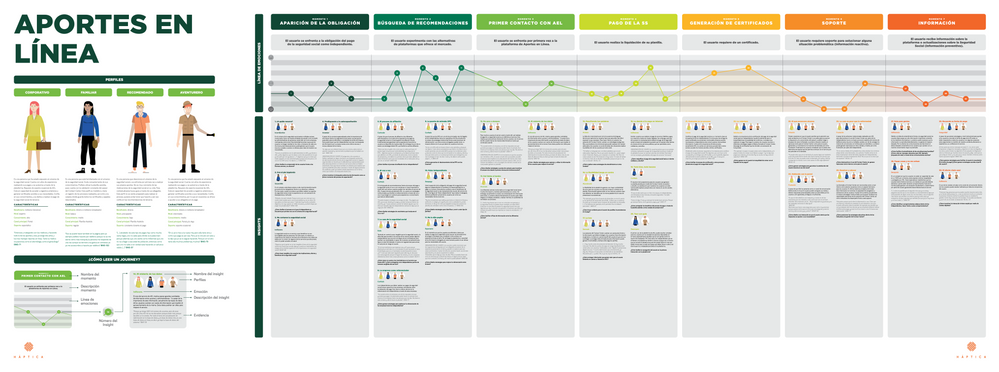
Making social security tangible.
Redesigning social security as trustworthy, and user-centered service for independent workers.
Project snapshot
Company: Haptica (Service Design Consultancy)
Client: Aportes en Linea
Role: Service Designer & Researcher
Duration: 3 months
Focus: Redesigning the service experience for independent workers to strengthen engagement and build trust.
Methods: In-depth interviews, observation (“fly on the wall”), journey mapping, profiling matrix, service blueprinting, co-creation workshops, and paper prototyping.
Impact: Enabled Aportes en Línea to offer a more personalized, tangible experience without compromising scalability. Defined a blueprint that continues to guide the company’s CX strategy.
What I did:
-
Led end-to-end research with 70+ users, combining interviews and on-site observation to uncover friction points in the social security payment journey.
-
Created customer archetypes, journey maps, and a service blueprint to visualize user behaviors and align internal teams.
-
Facilitated co-creation workshops with users and stakeholders to translate insights into tangible touchpoints.
-
Supervised and validated prototypes: from paper to digital mockups.
Becoming a trusted partner for future planning.
Customer journey of independent workers.
Context
Aportes en Línea leads Colombia’s PILA information operator market with a 43% share.
However, many workers ignore the benefits and importance of these payments — treating them as a bureaucratic obligation rather than a tool for well-being.
While AEL’s customer base was growing, independent workers felt disconnected and confused.
Key challenges:
-
Generalized ignorance of the impact of social security.
-
Lack of tangible elements in the service experience.
-
Desire for a closer, more human relationship with the company.
The team needed to uncover how users perceived “social security,” and reimagine how the service could feel supportive, transparent, and trustworthy.
My contribution


My Role
👉 Led the end-to-end research and service design process, from discovery through concept validation.
👉 Facilitated co-creation sessions with users and stakeholders to align on service principles and opportunities.
👉 Produced key decision tools — journey maps, profiling matrices, and service blueprints — used to guide implementation.

What I did
-
Conducted 70+ interviews with independent workers, customer service agents, and internal teams.
-
Applied “fly on the wall” observation to capture unspoken needs and emotional friction points.
-
Mapped the full service journey to visualize user emotions and operational touchpoints.
-
Created archetypes representing different user mindsets and needs.
-
Worked with design and strategy teams to develop modular touchpoints, from website prototypes to printed communication assets.
-
Validated prototypes through multiple rounds of paper prototyping and usability testing.

Outcomes
✅ Defined a new modular service model that made social security more approachable and relatable.
✅ Created a blueprint and journey map adopted as strategic CX tools by the company.
✅ Improved customer clarity and trust through transparent, personalized touchpoints.
✅ Established the value proposition: “The friend who easily guides me to build my well-being through social security.”
Field research of social security payment dynamics.
Process
01/
The challenge
Through 70+ interviews and field observations, we found that most users didn’t understand where their social security payments went, and relied heavily on call center agents for reassurance. This over-dependence on human help limited scalability.
02/
The Research
Using journey mapping and service blueprinting, we identified the most critical friction points and the backstage activities required to solve them.
We visualized both the emotional journey and operational dependencies, surfacing moments where communication could rebuild trust and transparency.
Tools used:
🧩 Fly-on-the-wall observation
🧩 Customer journey mapping
🧩 Profiling matrix
🧩 Service blueprinting
🧩 Paper prototyping
03/
Key Insights
-
Findings were translated into a modular service concept — a flexible system of touchpoints (digital and offline) that could adapt to user needs while maintaining a consistent, human tone of voice.
-
Each module was validated through iterative testing to ensure comprehension and usability.
-
“Turning a transactional obligation into a moment of care and connection.”
Service Innovation Workshops and Field Research.






